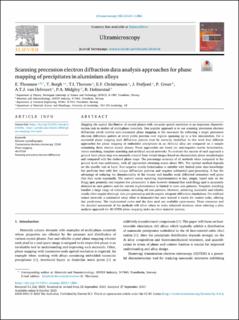| dc.contributor.author | Thronsen, Elisabeth | |
| dc.contributor.author | Bergh, Tina | |
| dc.contributor.author | Thorsen, Tor Inge | |
| dc.contributor.author | Christiansen, Emil | |
| dc.contributor.author | Frafjord, Jonas | |
| dc.contributor.author | Crout, Philip | |
| dc.contributor.author | Van Helvoort, Antonius Theodorus Johannes | |
| dc.contributor.author | Midgley, Paul A. | |
| dc.contributor.author | Holmestad, Randi | |
| dc.date.accessioned | 2024-03-18T10:24:21Z | |
| dc.date.available | 2024-03-18T10:24:21Z | |
| dc.date.created | 2023-11-28T12:42:41Z | |
| dc.date.issued | 2023 | |
| dc.identifier.issn | 0304-3991 | |
| dc.identifier.uri | https://hdl.handle.net/11250/3122826 | |
| dc.description.abstract | Mapping the spatial distribution of crystal phases with nm-scale spatial resolution is an important characterisation task in studies of multi-phase materials. One popular approach is to use scanning precession electron diffraction which enables semi-automatic phase mapping at the nanoscale by collecting a single precession electron diffraction pattern at every probe position over regions spanning up to a few micrometers. For a successful phase mapping each diffraction pattern must be correctly identified. In this work four different approaches for phase mapping of embedded precipitates in an Al-Cu-Li alloy are compared on a sample containing three distinct crystal phases. These approaches are based on: non-negative matrix factorisation, vector matching, template matching and artificial neural networks. To evaluate the success of each approach a ground truth phase map was manually created from virtual images based on characteristic phase morphologies and compared with the deduced phase maps. The percentage accuracy of all methods when compared to the ground truth was satisfactory, with all approaches obtaining scores above 98%. The optimal method depends on the specific task at hand. Non-negative matrix factorisation is suitable with limited prior data knowledge but performs best with few unique diffraction patterns and requires substantial post-processing. It has the advantage of reducing the dimensionality of the dataset and handles weak diffracted intensities well given that they occur repeatedly. The current vector matching implementation is fast, simple, based only on the Bragg spot geometry and requires few parameters. It does however demand that each Bragg spot is accurately detected in each pattern and the current implementation is limited to zone axis patterns. Template matching handles a large range of orientations, including off-axis patterns. However, achieving successful and reliable results often require thorough data pre-processing and do require adequate diffraction simulations. For artificial neural networks a substantial setup effort is demanded but once trained it excels for routine tasks, offering fast predictions. The implemented codes and the data used are available open-source. These resources and the detailed assessment of the methods will allow others to make informed decisions when selecting a data analysis approach for 4D-STEM phase mapping tasks on other material systems. | en_US |
| dc.description.abstract | Scanning precession electron diffraction data analysis approaches for phase mapping of precipitates in aluminium alloys | en_US |
| dc.language.iso | eng | en_US |
| dc.publisher | Elsevier | en_US |
| dc.rights | Navngivelse 4.0 Internasjonal | * |
| dc.rights.uri | http://creativecommons.org/licenses/by/4.0/deed.no | * |
| dc.title | Scanning precession electron diffraction data analysis approaches for phase mapping of precipitates in aluminium alloys | en_US |
| dc.title.alternative | Scanning precession electron diffraction data analysis approaches for phase mapping of precipitates in aluminium alloys | en_US |
| dc.type | Peer reviewed | en_US |
| dc.type | Journal article | en_US |
| dc.description.version | publishedVersion | en_US |
| dc.source.volume | 255 | en_US |
| dc.source.journal | Ultramicroscopy | en_US |
| dc.identifier.doi | 10.1016/j.ultramic.2023.113861 | |
| dc.identifier.cristin | 2203761 | |
| dc.relation.project | Norges forskningsråd: 237922 | en_US |
| dc.relation.project | Norges forskningsråd: 314063 | en_US |
| dc.relation.project | Norges forskningsråd: 301176 | en_US |
| dc.relation.project | Norges forskningsråd: 309584 | en_US |
| dc.relation.project | Norges forskningsråd: 197405 | en_US |
| dc.relation.project | Norges forskningsråd: 294933 | en_US |
| dc.relation.project | EC/H2020/823717 | en_US |
| dc.relation.project | Norges teknisk-naturvitenskapelige universitet: DIGITAL TRANSFORMATION | en_US |
| cristin.ispublished | true | |
| cristin.fulltext | original | |
| cristin.qualitycode | 1 | |

